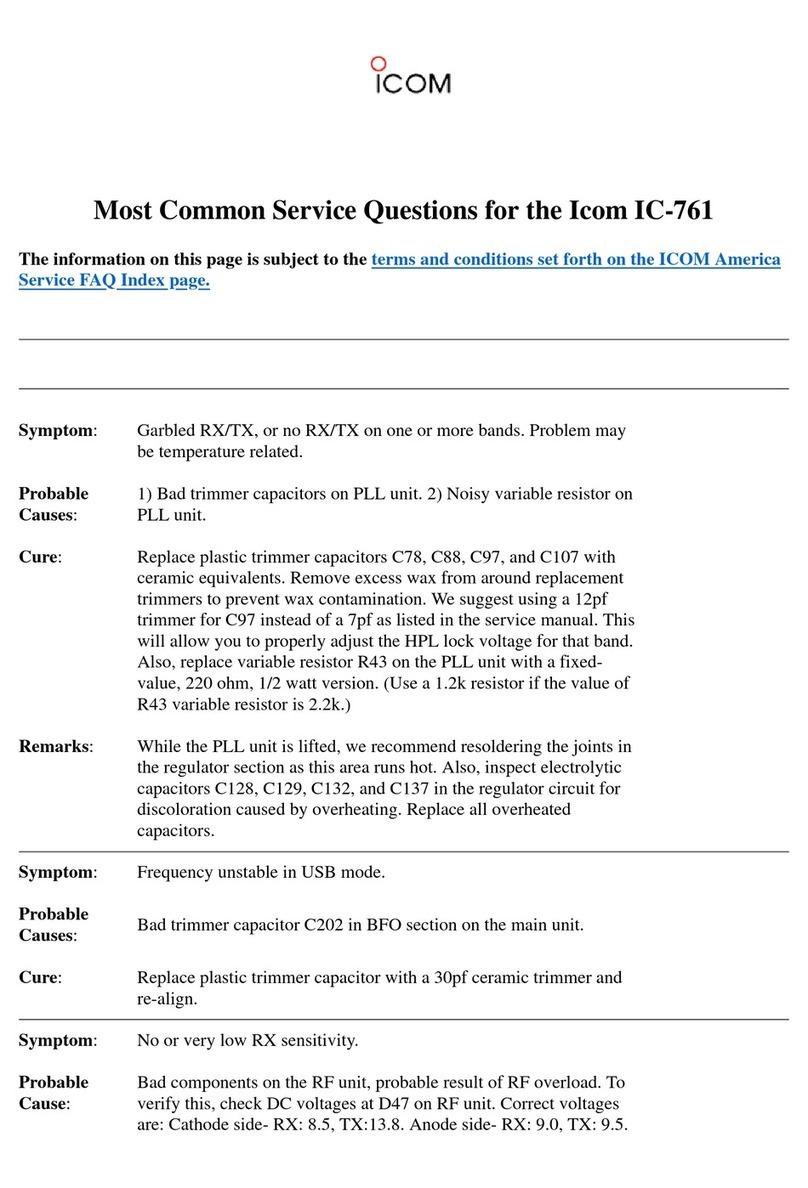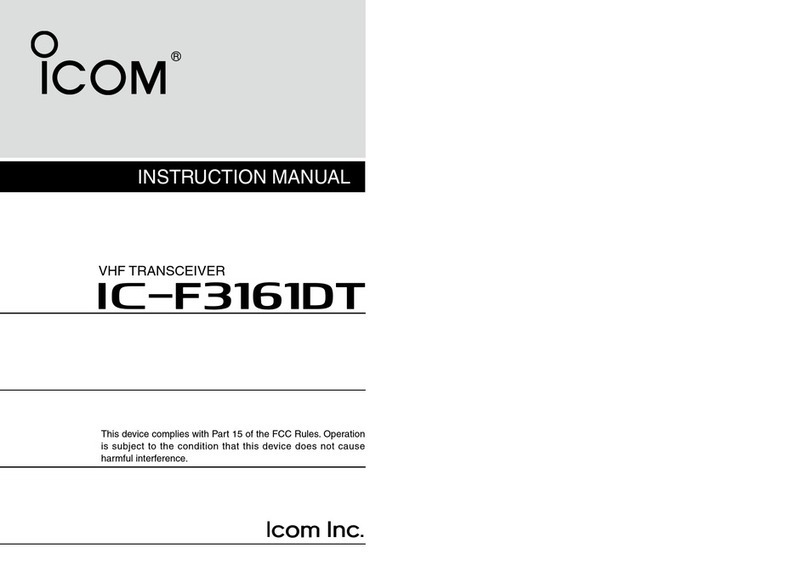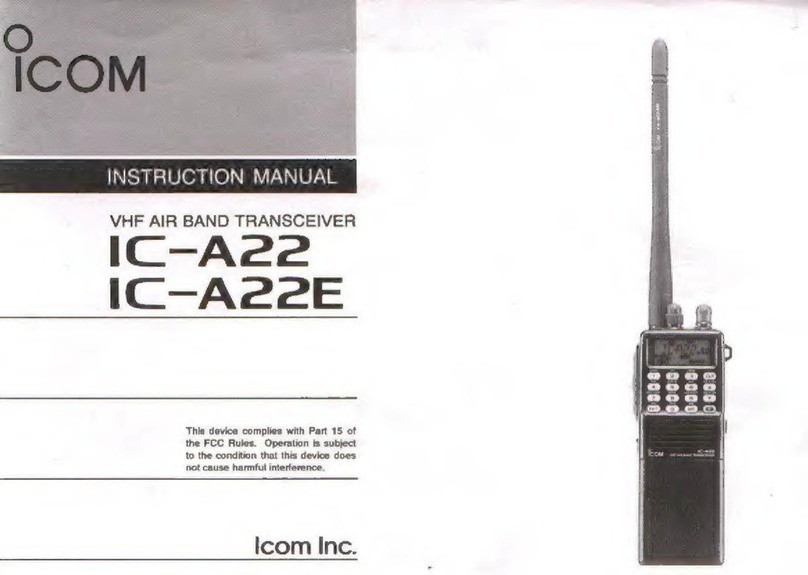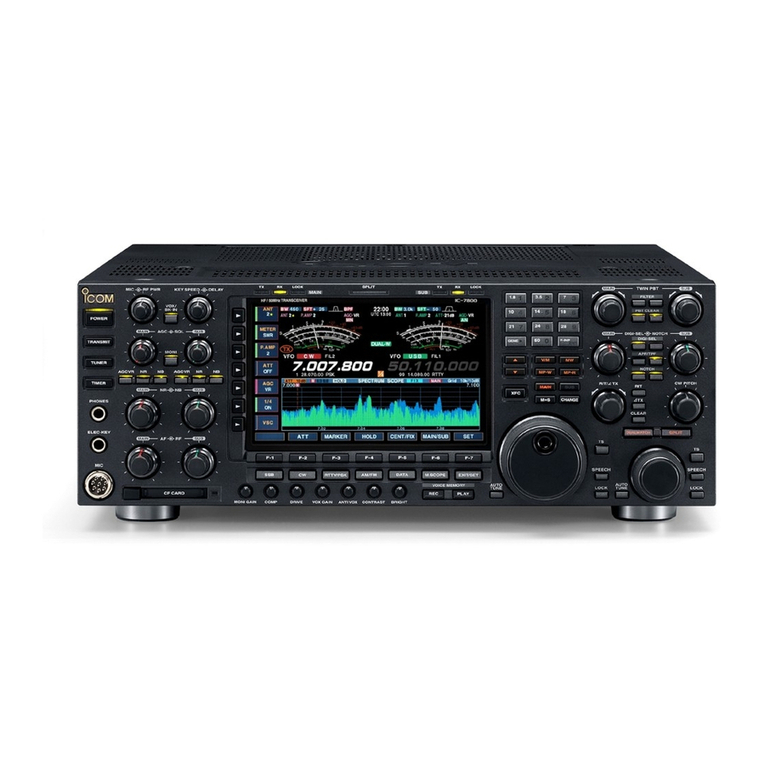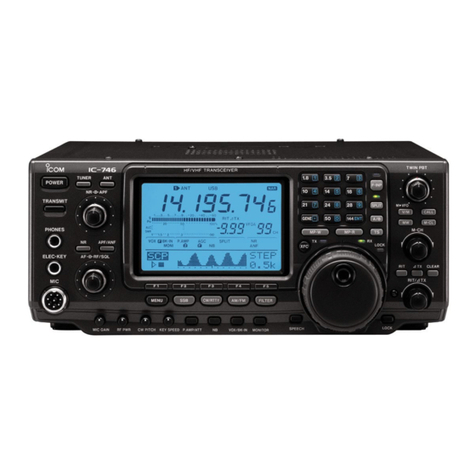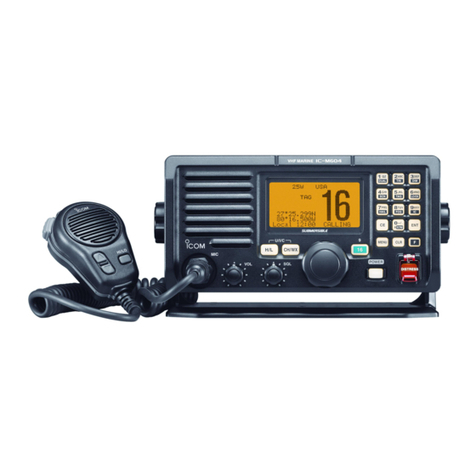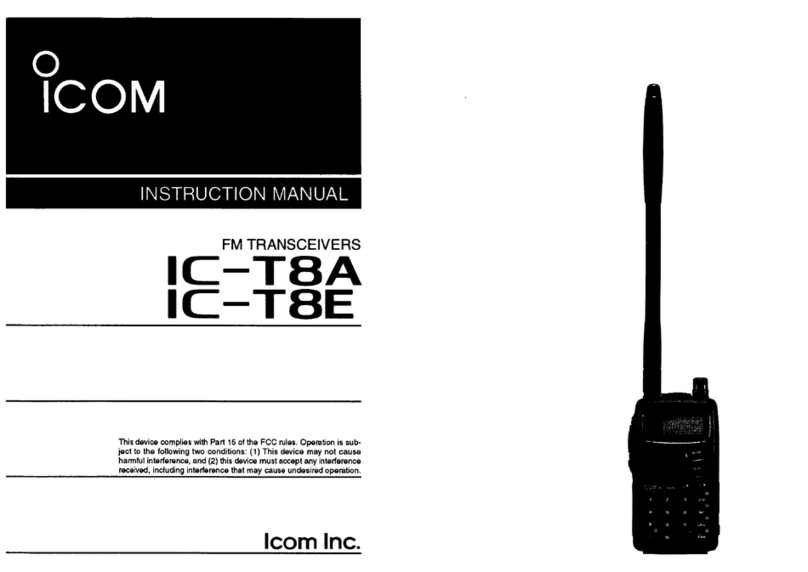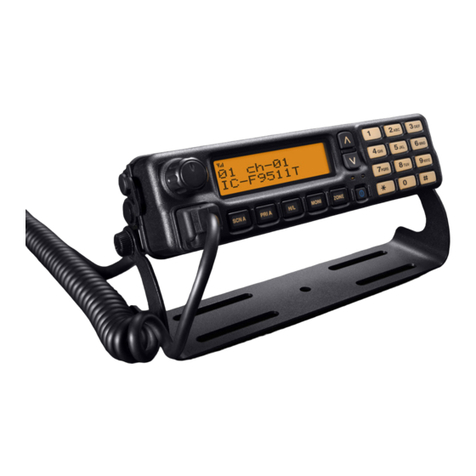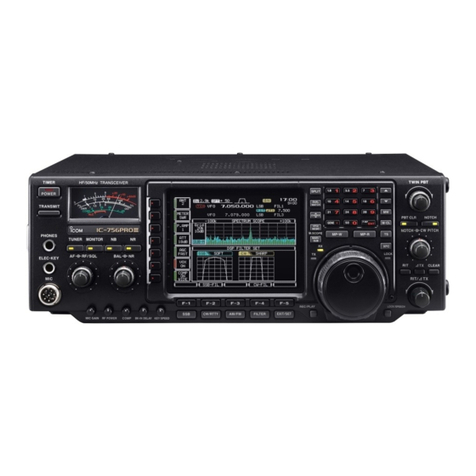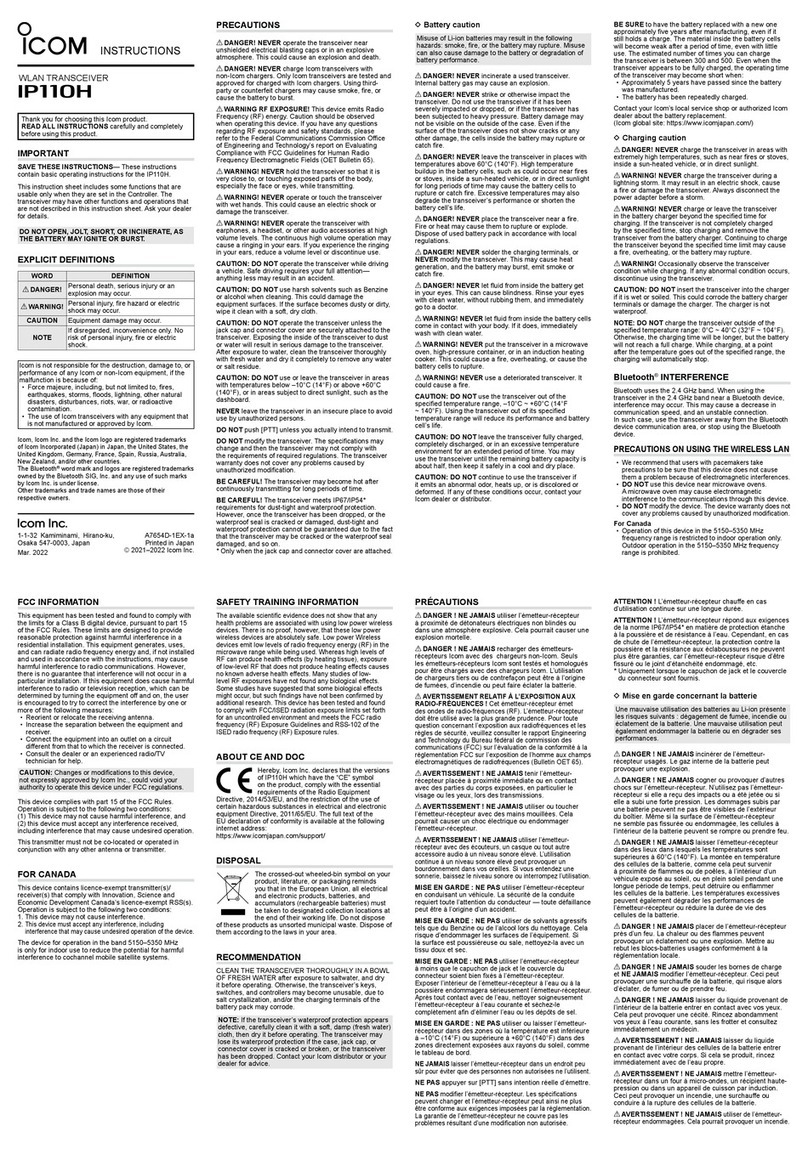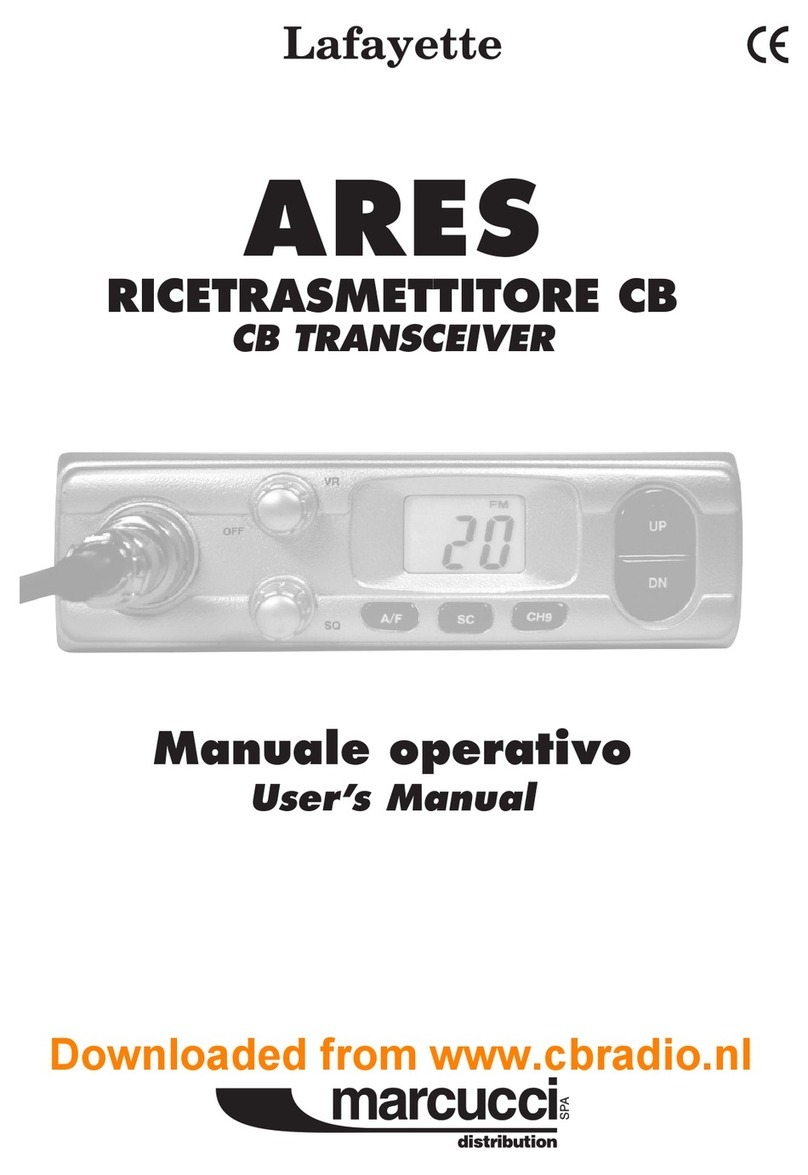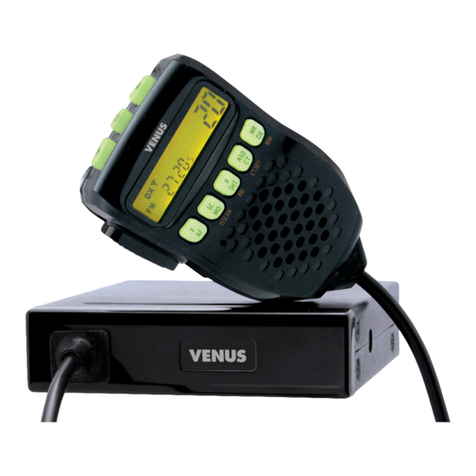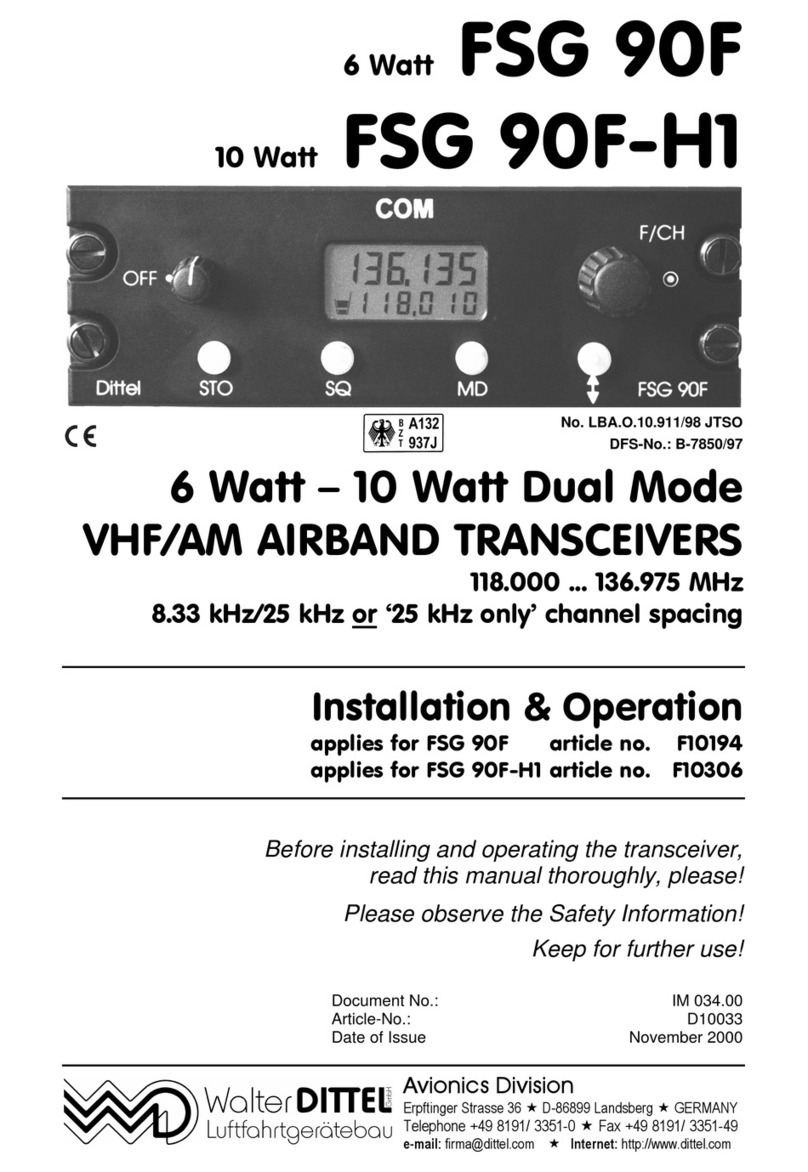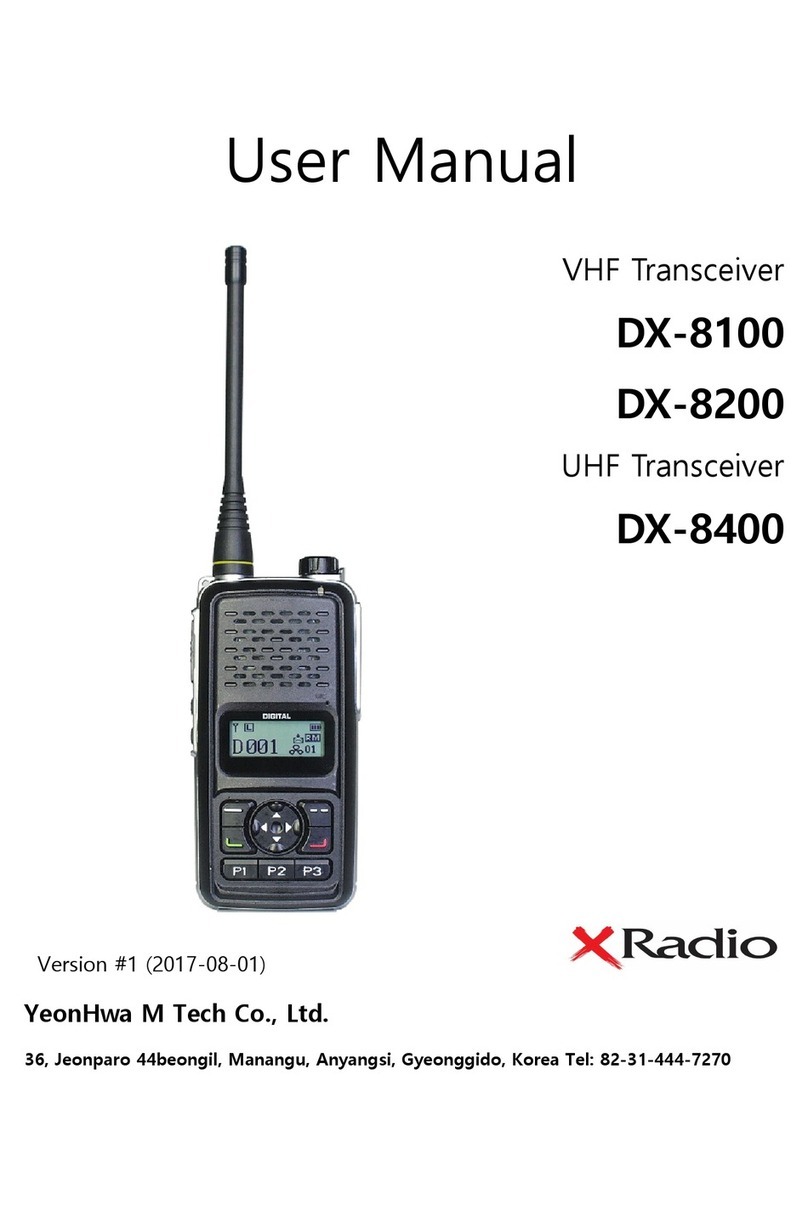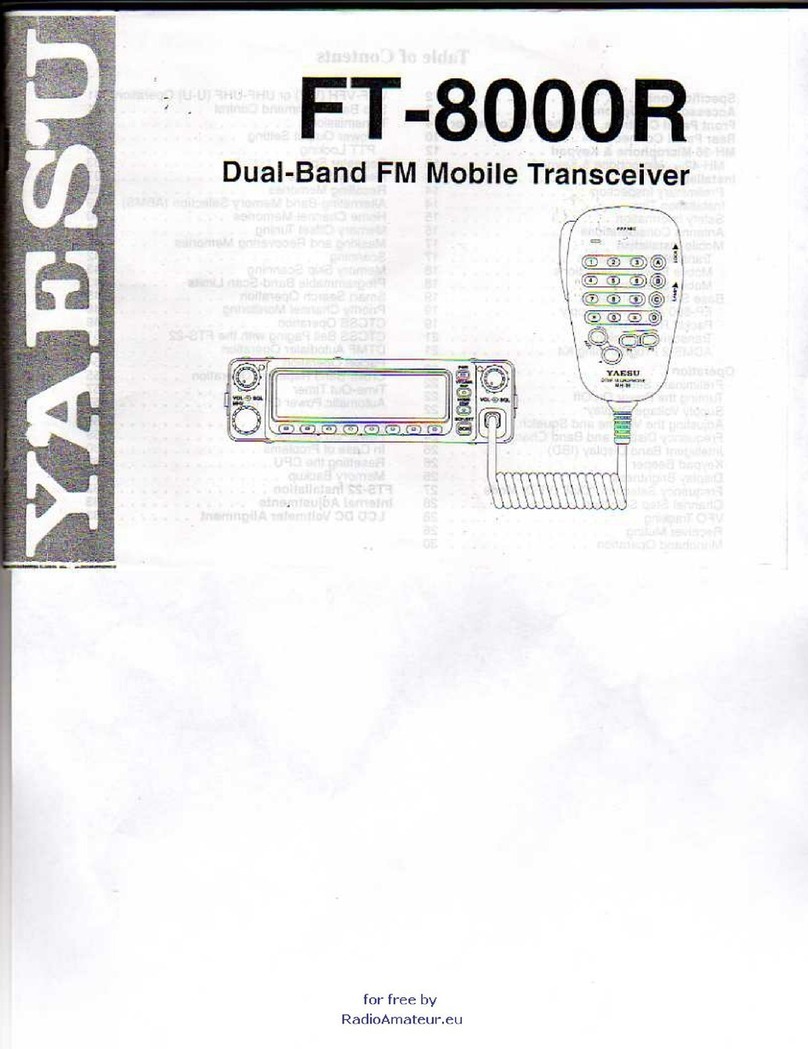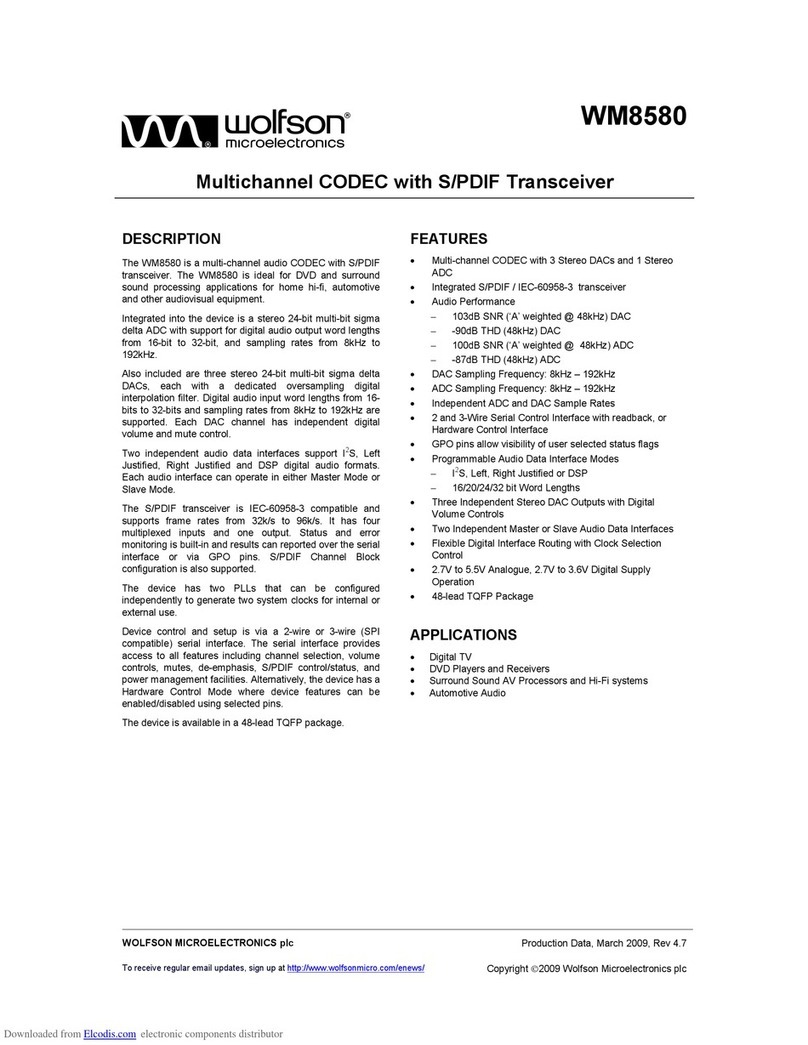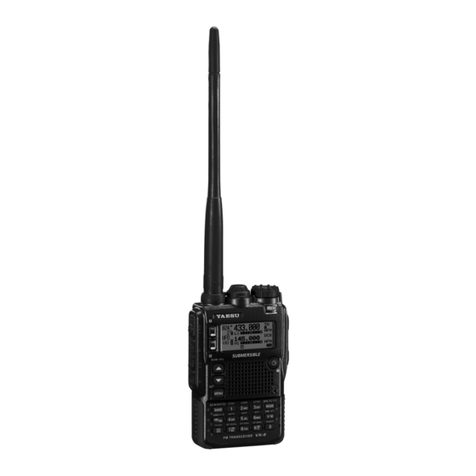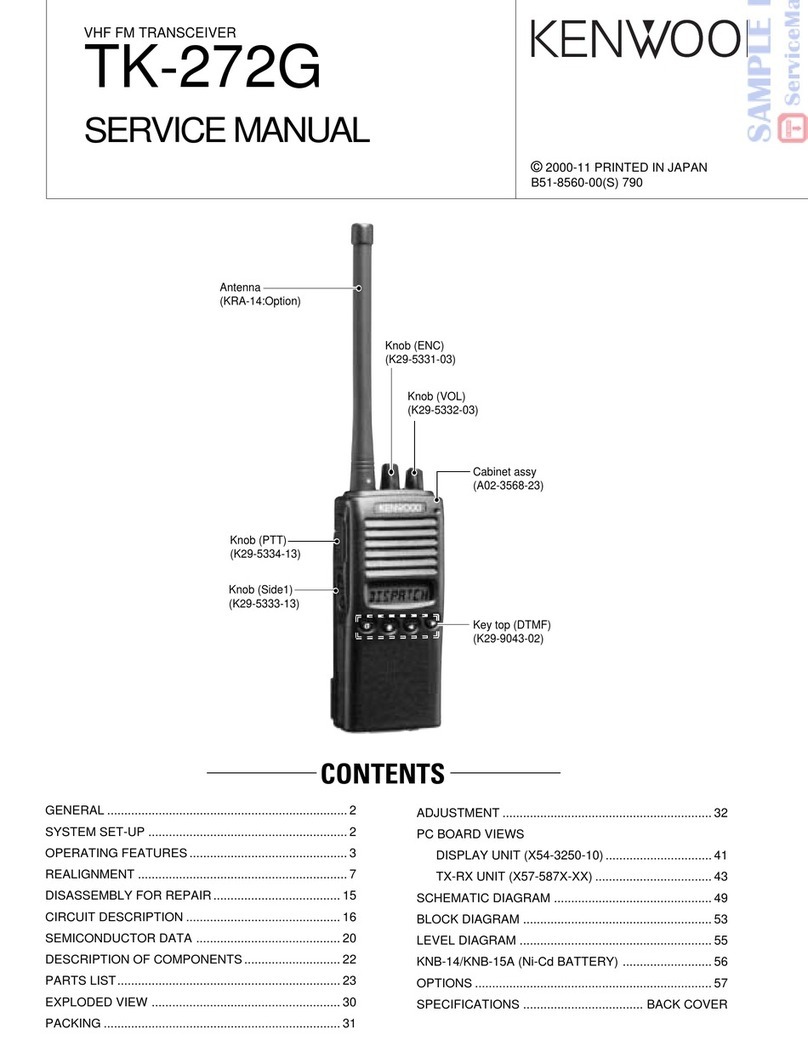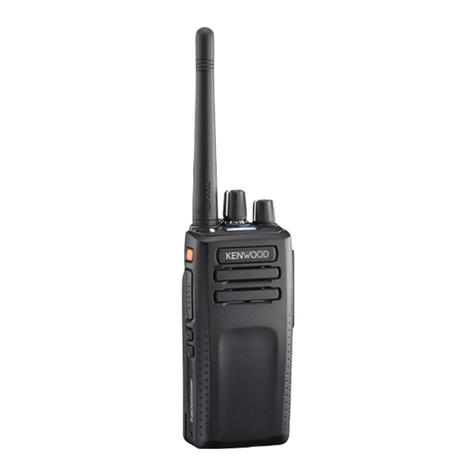Icom IC-M604 User manual

INSTRUCTION MANUAL
iM604
VHF MARINE TRANSCEIVER

i
FOREWORD
Thank you for purchasing this Icom transceiver. The IC-M604
vhf marine transceiver is designed and built with Icom’s
state of the art technology and craftsmanship. With proper
care, this transceiver should provide you with years of trou-
ble-free operation.
We want to take a couple of moments of your time to thank
you for making the IC-M604 your radio of choice, and hope
you agree with Icom’s philosophy of “technology first.” Many
hours of research and development went into the design of
your IC-M604.
DFEATURES
❍Built-in DSC meets ITU Class D requirement
❍Front and rear panel microphone connection
❍
Optional COMMANDMICII™ (HM-157) and
COMMANDMICIII™ (HM-162) are available and
up to two COMMANDMIC™s can be connected
❍
Easy to make individual DSC calls using Icom
’
s
MA-500TR Class B AIS Transponder
IMPORTANT
READ ALL INSTRUCTIONS carefully and completely
before using the transceiver.
SAVE THIS INSTRUCTION MANUAL — This in-
struction manual contains important operating instructions
for the IC-M604.
EXPLICIT DEFINITIONS
WORD DEFINITION
RWARNING!
CAUTION
NOTE
Personal injury, fire hazard or electric
shock may occur.
Equipment damage may occur.
Recommended for optimum use. No risk of
personal injury, fire or electric shock.
CLEAN THE TRANSCEIVER AND MICROPHONE
THOROUGHLY WITH FRESH WATER after exposure to
water including salt, otherwise, the keys and switch may
become inoperable due to salt crystallization.
Icom, Icom Inc. and the Icom logo are registered trademarks of Icom Incor-
porated (Japan) in Japan, the United States, the United Kingdom, Germany,
France, Spain, Russia and/or other countries.
COMMANDMIC is a registered trademark of Icom Incorporated (Japan) in the
United States.

ii
IN CASE OF EMERGENCY
If your vessel requires assistance, contact other vessels and
the Coast Guard by sending a Distress call on Channel 16.
USING CHANNEL 16
DISTRESS CALL PROCEDURE
1. “MAYDAY MAYDAY MAYDAY.”
2. “THIS IS ...............” (name of vessel).
3. Say your call sign or other indication of the vessel (AND
9-digit DSC ID if you have one).
4. “LOCATED AT ...............” (your position).
5. State the nature of the distress and assistance required.
6. Give any other information which might facilitate the
rescue.
Or, transmit your Distress call using digital selective calling
on Channel 70.
USING DIGITAL SELECTIVE CALLING (Ch 70)
DISTRESS CALL PROCEDURE
1. Whi l e l if t i ng u p t h e key cover, pu s h and h o ld
[DISTRESS] for 5 sec. until you hear 5 short beeps
change to one long beep.
2. Wait for an acknowledgment on Channel 70 from a
coast station.
• After the acknowledgement is received, Channel 16 is auto-
matically selected.
3. Push and hold [PTT], then transmit the appropriate
information as listed above.
NOTE
A WARNING STICKER is supplied with the transceiver.
To comply with FCC regulations, this sticker must be affixed in
such a location as to be readily seen from the operating con-
trols of the radio as in the diagram below. Make sure the cho-
sen location is clean and dry before applying the sticker.
EXAMPLE
WARNING
STICKER

iii
Icom requires the radio operator to meet the
FCC requirements for radio frequency expo-
sure. An omnidirectional antenna with gain not
greater than 9 dBi must be mounted a minimum
of 5 meters (measured from the lowest point of
the antenna) vertically above the main deck and all possible
personnel. This is the minimum safe separation distance es-
timated to meet all RF exposure compliance requirements.
This 5 meter distance is based on the FCC Safe Maximum
Permissible Exposure (MPE) distance of 3 meters added to
the height of an adult (2 meters) and is appropriate for all
vessels.
For watercraft without suitable structures, the antenna must
be mounted so as to maintain a minimum of 1 meter verti-
cally between the antenna, (measured from the lowest point
of the antenna), to the heads of all persons AND all persons
must stay outside of the 3 meter MPE radius.
Do not transmit with radio and antenna when persons are
within the MPE radius of the antenna, unless such persons
(such as driver or radio operator) are shielded from antenna
field by a grounded metallic barrier. The MPE radius is the
minimum distance from the antenna axis that person should
maintain in order to avoid RF exposure higher than the al-
lowable MPE level set by FCC.
FAILURE TO OBSERVE THESE LIMITS MAY ALLOW
THOSE WITHIN THE MPE RADIUS TO EXPERIENCE RF
RADIATION ABSORPTION WHICH EXCEEDS THE FCC
MAXIMUM PERMISSIBLE EXPOSURE (MPE) LIMIT.
IT IS THE RESPONSIBILITY OF THE RADIO OPERATOR
TO ENSURE THAT THE MAXIMUM PERMISSIBLE EXPO-
SURE LIMITS ARE OBSERVED AT ALL TIMES DURING
RADIO TRANSMISSION. THE RADIO OPERATOR IS TO
ENSURE THAT NO BYSTANDERS COME WITHIN THE
RADIUS OF THE MAXIMUM PERMISSIBLE EXPOSURE
LIMITS.
Determining MPE Radius
THE MAXIMUM PERMISSIBLE EXPOSURE (MPE) RA-
DIUS HAS BEEN ESTIMATED TO BE A RADIUS OF
ABOUT 3M PER OET BULLETIN 65 OF THE FCC.
THIS ESTIMATE IS MADE ASSUMING THE MAXIMUM
POWER OF THE RADIO AND ANTENNAS WITH A MAXI-
MUM GAIN OF 9dBi ARE USED FOR A SHIP MOUNTED
SYSTEM.
RADIO OPERATOR WARNING
W AR N IN G

iv
1
2
3
4
5
6
7
8
9
10
11
12
FOREWORD .................................................................................. i
IMPORTANT ................................................................................... i
EXPLICIT DEFINITIONS ................................................................ i
IN CASE OF EMERGENCY ........................................................... ii
NOTE .............................................................................................. ii
RADIO OPERATOR WARNING .................................................... iii
TABLE OF CONTENTS ................................................................. iv
PRECAUTIONS ............................................................................. v
1 OPERATING RULES ............................................................... 1
2 PANEL DESCRIPTION ........................................................ 2–6
■Panel description .................................................................. 2
■ Function display .................................................................... 4
■ Microphone ........................................................................... 6
3 BASIC OPERATION .......................................................... 7–12
■Channel selection ................................................................. 7
■Receiving and transmitting ................................................... 9
■Call channel programming .................................................. 10
■Microphone lock function .................................................... 10
■Display backlight ................................................................. 10
■Channel comments ............................................................. 11
■AquaQuake water draining function .................................... 11
■Optional Voice scrambler operation .................................... 12
4 DUALWATCH/TRI-WATCH .................................................... 13
■Description .......................................................................... 13
■Operation ............................................................................ 13
5 SCAN OPERATION ......................................................... 14–15
■Scan types .......................................................................... 14
■Setting TAG channels ......................................................... 15
■Starting a scan .................................................................... 15
6 DSC OPERATION ............................................................ 16–38
■MMSI code programming ................................................... 16
■DSC address ID .................................................................. 16
■Position and Time programming ......................................... 18
■Position and Time indication ............................................... 19
■GPS information indication ................................................. 19
■Distress call ........................................................................ 20
■Transmitting DSC calls ........................................................ 23
■Receiving DSC calls ........................................................... 32
■Received messages ........................................................... 36
■DSC Set mode .................................................................... 37
7 OTHER FUNCTIONS ....................................................... 39–42
■Intercom operation .............................................................. 39
■Hailer operation .................................................................. 40
■Automatic foghorn ............................................................... 41
■RX speaker function ........................................................... 42
8 SET MODE ....................................................................... 43–45
■Set mode programming ...................................................... 43
■Set mode items ................................................................... 43
9 CONNECTIONS AND MAINTENANCE ........................... 46–53
■Connections ........................................................................ 46
■Fuse replacement ............................................................... 47
■Supplied accessories .......................................................... 47
■Antenna .............................................................................. 47
■Mounting the transceiver .................................................... 48
■MB-75 installation ............................................................... 49
■UT-112/UT-98 installation .................................................... 50
■HM-157/HM-162 installation ............................................... 51
10 TROUBLESHOOTING ............................................................ 54
11 SPECIFICATIONS AND OPTIONS .................................. 55–56
■Specifications....................................................................... 55
■Options ................................................................................ 56
12 CHANNEL LIST ..................................................................... 57
TABLE OF CONTENTS

v
RWARNING! NEVER connect the transceiver to an
AC outlet. This may pose a fire hazard or result in an electric
shock.
RWARNING! NEVER connect the transceiver to a
power source of more than 16 V DC or use reverse polarity.
This will ruin the transceiver.
RWARNING! NEVER cut the DC power cable between
the DC plug and fuse holder. If an incorrect connection is
made after cutting, the transceiver may be damaged.
CAUTION: NEVER place the transceiver where normal
operation of the vessel may be hindered or where it could
cause bodily injury.
CAUTION: Changes or modifications to this device, not
expressly approved by Icom Inc., could void your authority to
operate this device under FCC regulations.
KEEP the
transceiver and microphone at least 1 m (3.3 ft)
away from the vessel’s magnetic navigation compass.
DO NOT use or place the transceiver in areas with tem-
peratures below –20°C (–4°F) or above +60°C (+140°F) or,
in areas subject to direct sunlight, such as the dashboard.
DO NOT use chemical agents such as benzine or alcohol
when cleaning, as they may damage the transceiver sur-
faces. If the transceiver becomes dusty or dirty, wipe it clean
with a soft, dry cloth.
BE CAREFUL! The transceiver rear panel will become
hot when operating continuously for long periods.
Place the transceiver in a secure place to avoid inadvertent
use by children.
BE CAREFUL! The transceiver and the optional HM-157
commandmicii™/HM-162* commandmiciii™employ water-
proof construction, which corresponds to IPX7. However,
once the transceiver or microphone has been dropped, wa-
terproof protection cannot be guaranteed because of possi-
ble damage to the transceiver’s or microphone’s case or the
waterproof seal.
* Equivalent to IPX8
Approved Icom optional equipment is designed for optimal
performance when used with an Icom transceiver.
Icom is not responsible for the destruction or damage to an
Icom transceiver in the event the Icom transceiver is used
with equipment that is not manufactured or approved by
Icom.
PRECAUTIONS

1
1
OPERATING RULES
1
DPRIORITIES
• Read all rules and regulations pertaining to priorities and
keep an up-to-date copy handy. Safety and Distress calls
take priority over all others.
• You must monitor Channel 16 when you are not operating
on another channel.
• False or fraudulent distress signals are prohibited and pun-
ishable by law.
DPRIVACY
• Information overheard but not intended for you cannot law-
fully be used in any way.
• Indecent or profane language is prohibited.
DRADIO LICENSES
(1) SHIP STATION LICENSE
You must have a current radio station license before using
the transceiver. It is unlawful to operate a ship station which
is not licensed.
Inquire through your dealer or the appropriate government
agency for a Ship-Radiotelephone license application. This
government-issued license states the call sign which is your
craft’s identification for radio purposes.
(2) OPERATOR’S LICENSE
A Restricted Radiotelephone Operator Permit is the license
most often held by small vessel radio operators when a radio
is not required for safety purposes.
The Restricted Radiotelephone Operator Permit must be
posted or kept with the operator. Only a licensed radio op-
erator may operate a transceiver.
However, non-licensed individuals may talk over a trans-
ceiver if a licensed operator starts, supervises, ends the call
and makes the necessary log entries.
a copy of the current government rules and regulations
handy.
Radio license for boaters (U.S.A. only)
The Telecommunications Act of 1996 permits recreational
boaters to have and use a VHF marine radio, EPIRB, and
marine radar without having an FCC ship station license.
Boaters traveling on international voyages, having an HF
single sideband radiotelephone or marine satellite termi-
nal, or required to carry a marine radio under any other
regulation must still carry an FCC ship station license.
For further information, see the FCC Ship Radio Stations
Fact Sheet.

2
PANEL DESCRIPTION
2
■Panel description
U/I/C
H/L
CH/WX
9
16
DISTRESS
POWER
VOL
iM604
VHF MARINE
MIC
U/I/C 9
H/L
CH/ WX
16
SQL
DISTRESS
Speaker Function display (p. 4) !3
q!2 tyui!1 !0 o r e w
qCLEAR KEY [CLR]
Push to cancel the entered function, exit Set mode. (p. 43)
wFUNCTION KEY [F]
After pushing this key, some keys perform secondary
functions.
• “F” appears when a secondary function can be accessed.
eDISTRESS KEY [DISTRESS] (pp. 20, 22)
Push and hold for 5 sec. to transmit a Distress call.
rDSC MENU KEY [MENU] (p. 16)
Push to toggle the DSC menu ON or OFF.
tPOWER KEY [POWER] (p. 9)
➥Push to turn power ON.
➥Push and hold for 1 sec. to turn power OFF.
yCHANNEL 16/CALL CHANNEL KEY [16•9]
➥Push to select Channel 16. (p. 7)
➥
Push and hold for 1 sec. to select the call channel. (p. 7)
• “CALL” appears when the call channel is selected.
➥
Push and hold for 3 sec. to enter call channel program-
ming condition when the call channel is selected. (p. 10)
➥While pushing and holding [H/L], push to enter channel
comments programming condition. (p. 11)
➥While turning power ON, push to enter Set mode.
(p. 43)
uSELECTOR DIAL [SELECTOR] (pp. 7–9)
Rotate to select the operating channels, set mode con-
tents, etc.
iCHANNEL/WEATHER CHANNEL KEY [CH/WX]
➥Selects and toggles the regular channels and weather
channels when pushed momentarily. (p. 8)
➥While pushing and holding [H/L], push to select one of
three channel groups in sequence. (p. 8)
• U.S.A., International and Canadian channel groups are avail-
able.
oSQUELCH CONTROL [SQL] (p. 9)
Rotate to set the squelch threshold level.

When the lcom MA-500TR CLASS B AIS TRANSPONDER is con-
nected to your IC-M504/IC-M505/IC-M603/IC-M604 VHF MARINE
TRANSCEIVER, an individual DSC call can be transmitted to a
selected AIS target using the transponder, without needing to
enter the target’s MMSI code.
See the transponder’s manual for connecting instructions.
To ensure correct operation of the DSC function, make
sure you correctly set the transceiver’s squelch.
MAKING AN INDIVIDUAL DSC CALL USING AN AIS TRANSPONDER
Procedures Transponder’s display Transceiver’s display
Step q: Transponder’s operation
Select a desired AIS target on the plotter, target list or danger list
display.
• You can also go to the next step whenever the detail screen of the AIS
target is displayed.
• Make sure the transceiver is in the normal operating mode. Otherwise,
you cannot make an individual DSC call using the transponder.
Step w: Transponder’s operation
Push [DSC] to display the voice channel selection screen, and then
push [Y] or [Z]to select a desired voice channel*.
• Voice channels are already preset into the transponder in recommended
order.
*When a base station is selected in step q, a voice channel will be spec-
ified by the base station, therefore you cannot change the channel. The
transponder will display “Voice Channel is specified by the Base station,”
in this case.
Step e: Transponder’s operation
Push [DSC] to make the transceiver to transmit an individual DSC
call to the AIS target.
• If Channel 70 is busy, the transceiver stands by until the channel becomes
clear.
• If the transceiver cannot make the call, the transponder will display “DSC
Transmission FAILED.”
Individual Call
Step r: Transponder’s operation
After making the individual DSC call, the transponder will display
“DSC Transmission COMPLETED.”
• Push [CLEAR] to return to the previous screen before you entered the
voice channel selection screen in step w.
• The transceiver stands by on Channel 70 until an acknowledgement is
received.
Individual Call
TX Complete
Now Waiting for ACK
<CLR Exit>
Step t: Transceiver’s operation
When the acknowledgement ‘Able to comply’ is received, beeps
sound and the transceiver automatically selects the channel spec-
ified in step w.
If the acknowledgement ‘Unable to comply’ is received, beeps sound
and the transceiver’s display returns to the operating channel select-
ed before making the individual DSC call.
• Push [CLR] to stop the beeps.
• You can check the MMSI code or the name (if programmed) of the AIS
target on the display.
Step y: Transceiver’s operation
After receiving the acknowledgement ‘Able to comply’ in step t,
push and hold [PTT] to communicate with the AIS target.
[DSC]
[CLEAR]
[Z]
[Y]
TRANSPONDER
A-6527D-3EX
25W INT
DUP
Received
Unable ACK
<123456789
<CLR˘
Beep Off> INTL
‘Unable to comply’ is received.
16
TRANSCEIVER (IC-M603/M604)
[CLR]
[PTT]
(Example)
25W INT
DUP
34°34.506N
123°23.236W
UTC 12:00 INTL
‘Able to comply’ is received
‘Unable to comply’ is received
25W INT
Received
INDV ACK
<123456789
<CLR˘
Beep Off> COMMERCIAL
These instructions are based on using the IC-M604. The dis-
played screens, indications or operations may differ slightly
from the instructions, depending on the transceiver.
Other manuals for IC-M604
5
Other Icom Transceiver manuals
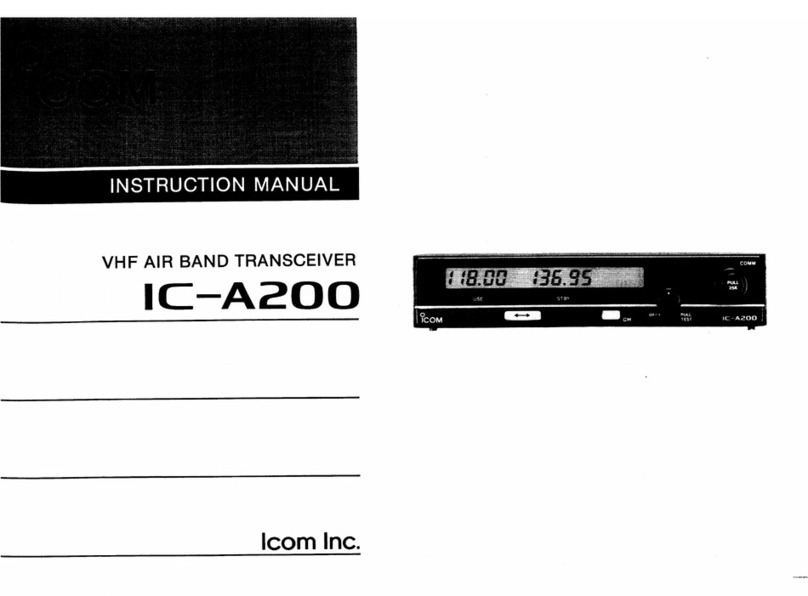
Icom
Icom IC-A200 User manual

Icom
Icom IC-F5020 Series User manual
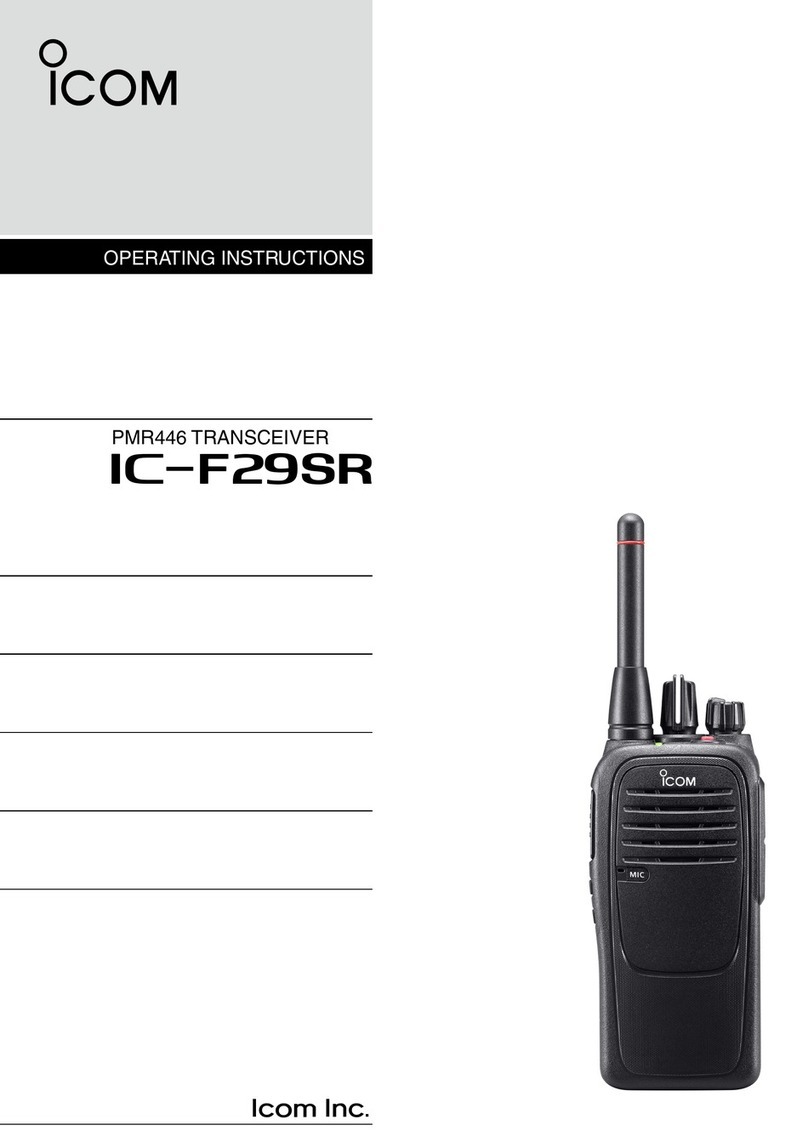
Icom
Icom IC-F29SR User manual
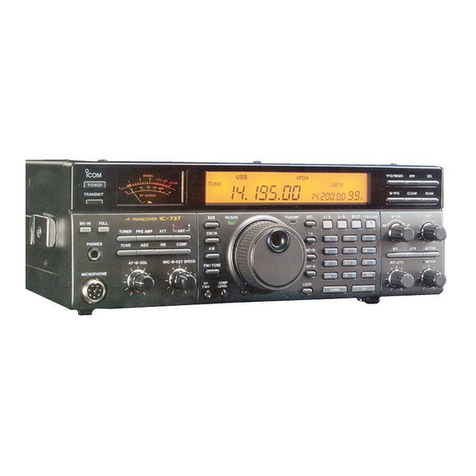
Icom
Icom IC-737 User manual
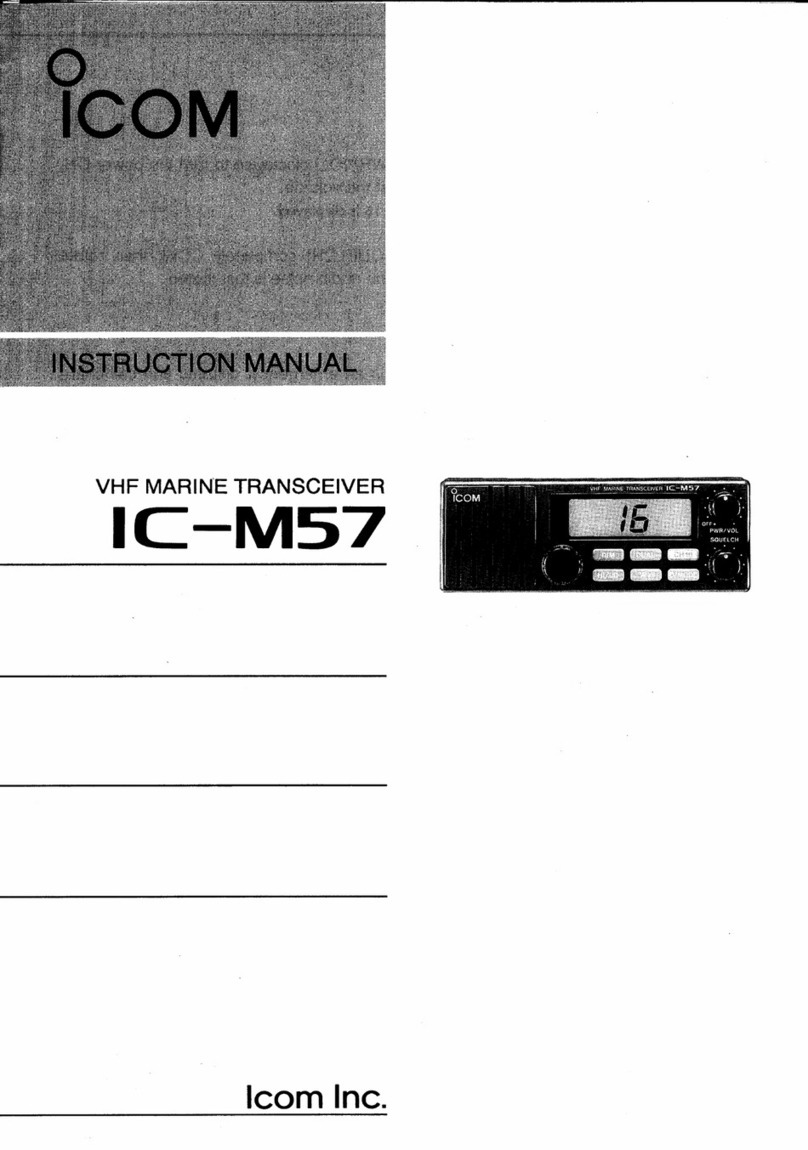
Icom
Icom IC-M57 User manual
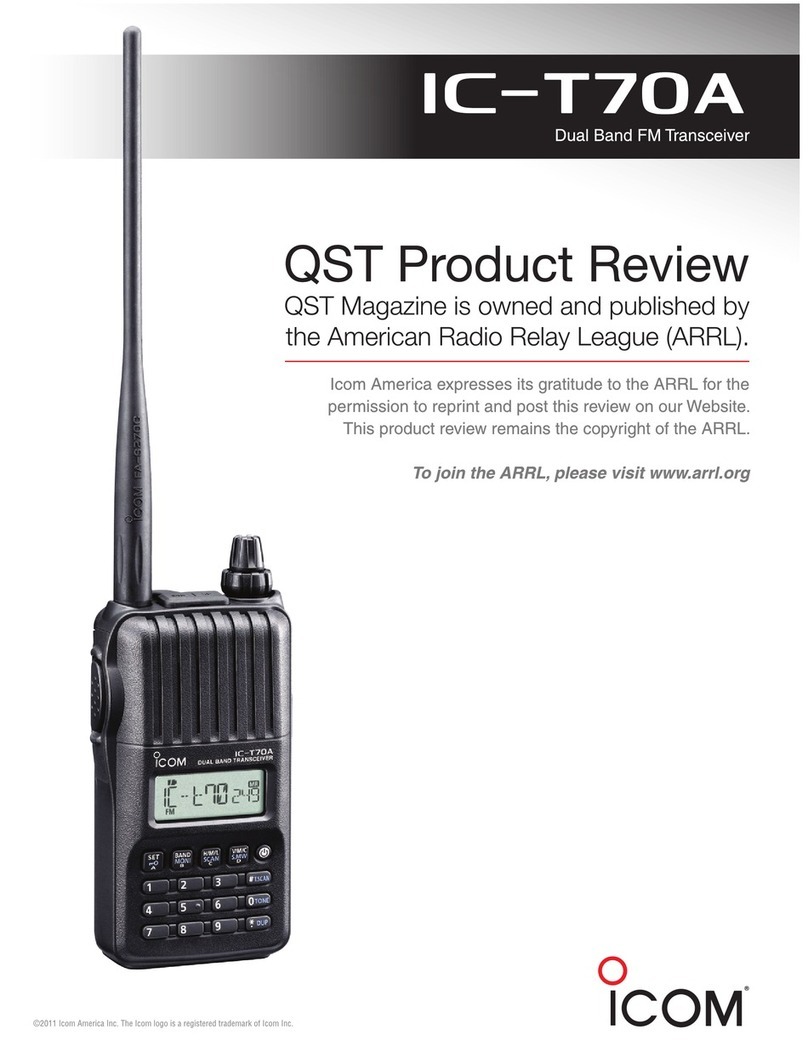
Icom
Icom IC-T70A User manual
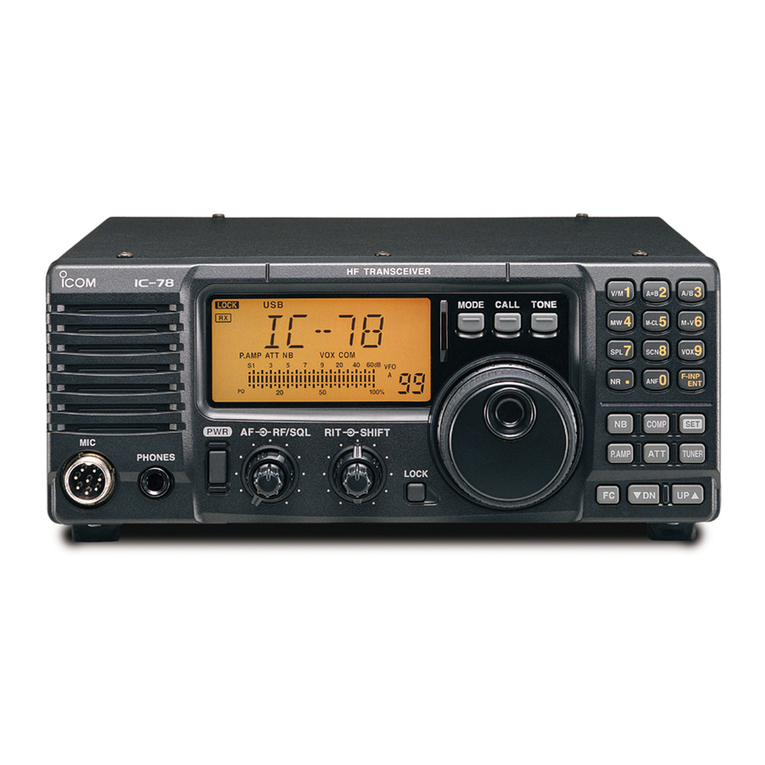
Icom
Icom IC-78 Assembly instructions
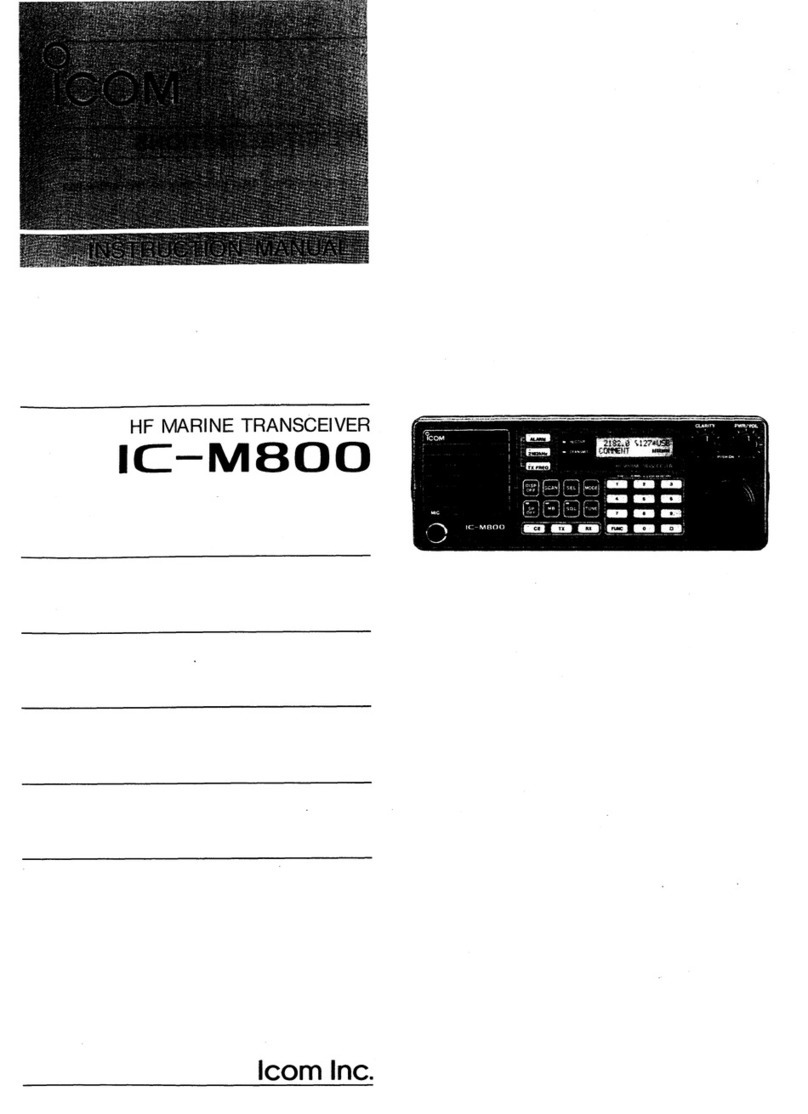
Icom
Icom IC-M800 User manual

Icom
Icom IC-F4GT Building instructions

Icom
Icom IC-7100 User manual
